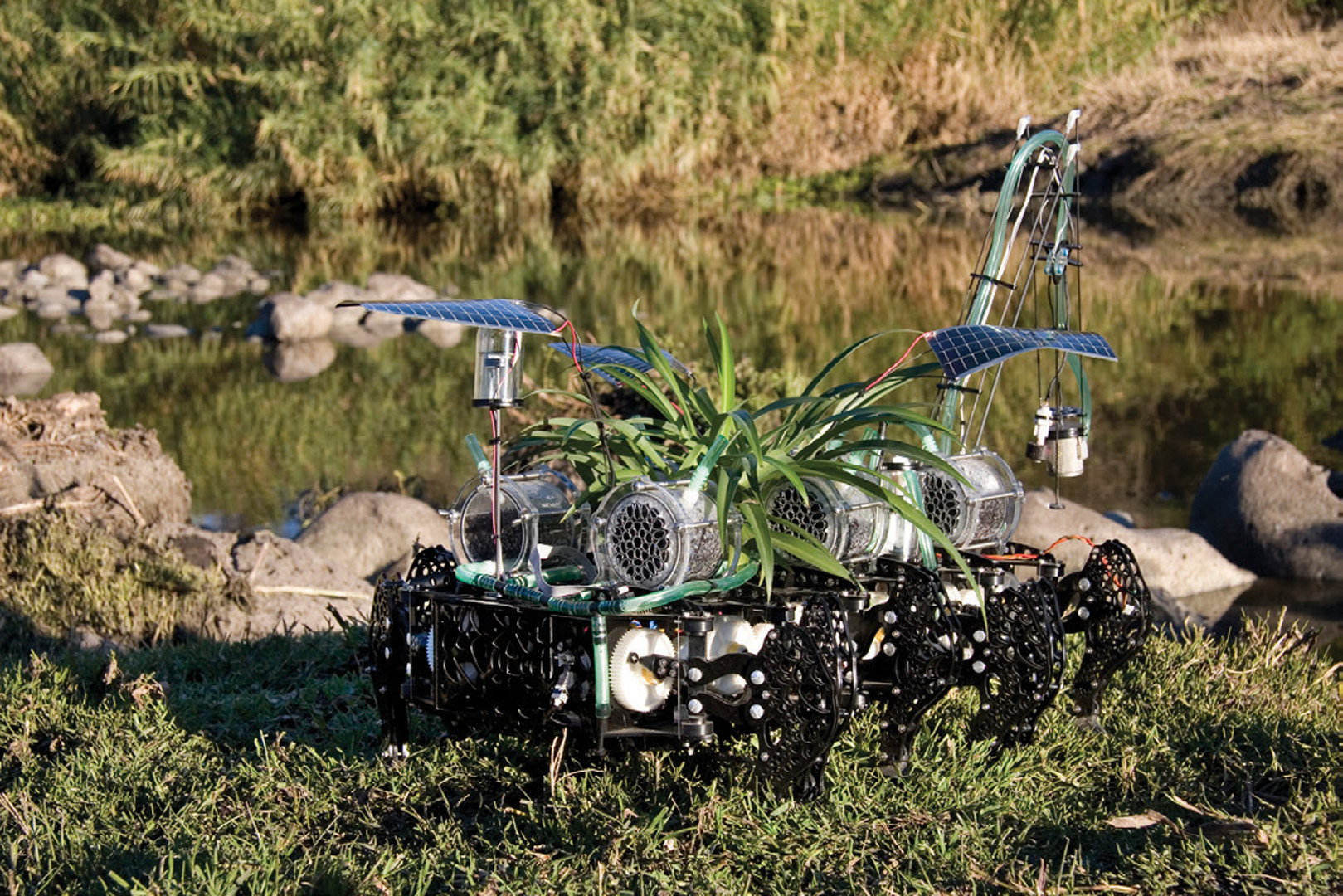“Aesthetics of Biocybernetic Designs: A Systems Approach to Biorobots and Its Implications for the Environment” by Thompson and Mukhopadhyay
Conference:
Type(s):
Title:
- Aesthetics of Biocybernetic Designs: A Systems Approach to Biorobots and Its Implications for the Environment
Presenter(s)/Author(s):
Abstract:
The authors identify some of the theoretical premises of biocybernetic art objects, with reference to the works of Nam June Paik, Edward Ihnawitz, Ulrike Gabriel, and most notably, Gilberto Esparza, the Mexican biocybernetic artist. Systems theory anticipates stochastic convergences in nature, defying the classic certitude of the teleological notion of form. Evidence for this paradigmatic shift is found in the biocybernetic creatures conceived by these roboticists. In much biocybernetic art, beauty emerges in the form of adaptive mechanisms, such as in robotic tetrapods or self-organizing artificial plants. Such structures provide a template for survival mechanisms in an increasingly entropic environment.
References:
1. De Sousa, Ronald, ?Is Art an Adaptation? Prospects for an Evolutionary Perspective on Beauty,? The Journal of Aesthetics and Art Criticism 62, No. 2, 109?118 (Spring 2004); Thomas, David J., ?Biological Aspects of the Ecopoiesis and Terraformation of Mars,? Journal of the British Interplanetary Society, 415?418 (1995).
2. Bedau, Mark, ?The Scientific and Philosophical Scope of Artificial Life,? Leonardo 35, No. 4, 395?400 (August 2002); Parreira Correia, Lu?s Miguel, ?From Natural to Artificial Life,? Revista Portuguesa de Filosofia, T. 66, Fasc. 4, 789?802 (2010); Peterson, Ivars, ?Artificial Reality,? Science News 127, No. 25, 396?397 (June 1985).
3. Burnham, Jack, ?Systems Esthetics,? Artforum 7, No. 1, 31?37 (September 1968).
4. Kac, Eduardo, ?Foundation and Development of Robotic Art,? Art Journal 56, No. 3, 60?67 (Autumn 1997).
5. Lin, Po-Hsien, ?A Dream of Digital Art: Beyond the Myth of Contemporary Computer Technology in Visual Arts,? Visual Arts Research 31, No. 1 (60), 4?12 (2005).
6. Hood, Ernie, ?Robolobsters: The Beauty of Biomimetics,? Environmental Health Perspectives 112, No. 8, A486?A489 (June 2004).
7. Dissanayake, Ellen, Art and Intimacy: How the Arts Began (Seattle, WA: University of Washington Press, 2000).
8. Weiner, Norbert, Cybernetics: Or Control and Communication in the Animal and the Machine (Cambridge, MA: MIT Press, 1965).
9. Holland, J. H., Adaptation in Natural and Artificial Systems, 2nd ed. (Cambridge, MA: MIT Press, 1992).
10. Capra, Fritjof, The Web of Life. A New Scientific Understanding of Living Systems (New York: Anchor Books, 1997).
11. Brand, Stewart, Whole Earth Discipline: An Ecopragmatist Manifesto (London, UK: Atlantic Books, 2009).
12. Gombrich, Ernst, Reflections on the History of Art: Views and Reviews (Oakland, CA: University of California Press, 1987).
13. Hood, Ernie, ?Robolobsters: The Beauty of Biomimetics,? Environmental Health Perspectives 112, No. 8, 486 (June 2004).
14. Dawkins, Richard, The Selfish Gene (Oxford, UK: Oxford University Press, 1989).
15. Cho, Adrian, ?Making Machines That Make Others of Their Kind,? Science 318, No. 5853, 1084?1085 (November 2007); Meleka, J., ?Will the Robot Change the World or the World Change the Robot?A User Point of View,? Journal of the Royal Society of Arts 131, No. 5327, 657?670 (October 1983).
16. Capra, Fritjof, The Web of Life: A New Scientific Understanding of Living Systems (New York: Random House, 1996).
17. De Sousa, Ronald, ?Is Art an Adaptation? Prospects for an Evolutionary Perspective on Beauty,? The Journal of Aesthetics and Art Criticism 62, No. 2, 109 (Spring 2004).
18. Cho, Adrian, ?Making Machines That Make Others of Their Kind,? Science 318, No. 5853, 660 (November 2007).
19. Wilson, Stephen, Information Arts: Intersections of Art, Science, and Technology (Cambridge, MA: MIT Press, 2002).
20. Rusk, Natalie et al., ?New Pathways Into Robotics: Strategies for Broadening Participation,? Journal of Science Education and Technology 17, No. 1, 59?69 (February 2008).
21. Bellingham, James G., and Kanna Rajan, ?Robotics in Remote and Hostile Environments,? Science 318, No. 5853, 1098?1102 (November 2007).
22. White, Norman, <www.youtube.com/watch?v=uCzfBOfP42c> (2013), accessed March 19, 2014.
23. Kac, Eduardo, ?Dialogical Telepresence and Net Ecology,? The Robot in the Garden: Telerobotics and Telepistemology in the Age of the Internet, ed. Ken Goldberg (Cambridge, MA: MIT Press, 2000).
24. Gabriel, Ulrike, <www.foro-artistico.de/deutsch/programm/review/sensystem.html> (1993), accessed March 21, 2014.
25. Klein, Yves Amu, ?Living Sculpture: The Art and Science of Creating Robotic Life,? Leonardo 31, No. 5, 393?396 (October 1998).
26. Karakasiliotis, Konstantinos et al., ?Where Are We in Understanding Salamander Locomotion: Biological and Robotic Perspectives on Kinematics,? Biological Cybernetics 107, No. 5, 529?544 (October 2013).
27. Hood, Ernie, ?Robolobsters: The Beauty of Biomimetics,? Environmental Health Perspectives 112, No. 8, 115 (June 2004).
28. Pfeifer, Rolf, Max Lungarella, and Fumiya Iida, ?Self-Organization, Embodiment, and Biologically Inspired Robotics,? Science 318, No. 5853, 1088?1093 (November 2007); Weiss, Peter, ?In Its Own Image,? Science News 167, No. 20, 310 (May 2005).
29. Hillis, W. D., ?Co-evolving Parasites Improve Simulated Evolution as an Optimization Procedure,? Physica D 42, No. 1?3, 228?234 (June 1990).
30. Fujita, Masahiro, ?How to Make an Autonomous Robot as a Partner with Humans: Design Approach Versus Emergent Approach,? Philosophical Transactions: Mathematical, Physical and Engineering Sciences 365, No. 1850, 21?47 (January 2007).
31. Waltz, David. L., ?The Prospects for Building Truly Intelligent Machines,? Daedalus 117, No. 1, 191?212 (Winter 1988); Flood, Merrill M., ?What Future Is There for Intelligent Machines?? Audio Visual Communication Review 11, No. 6, 260?270 (1963).





